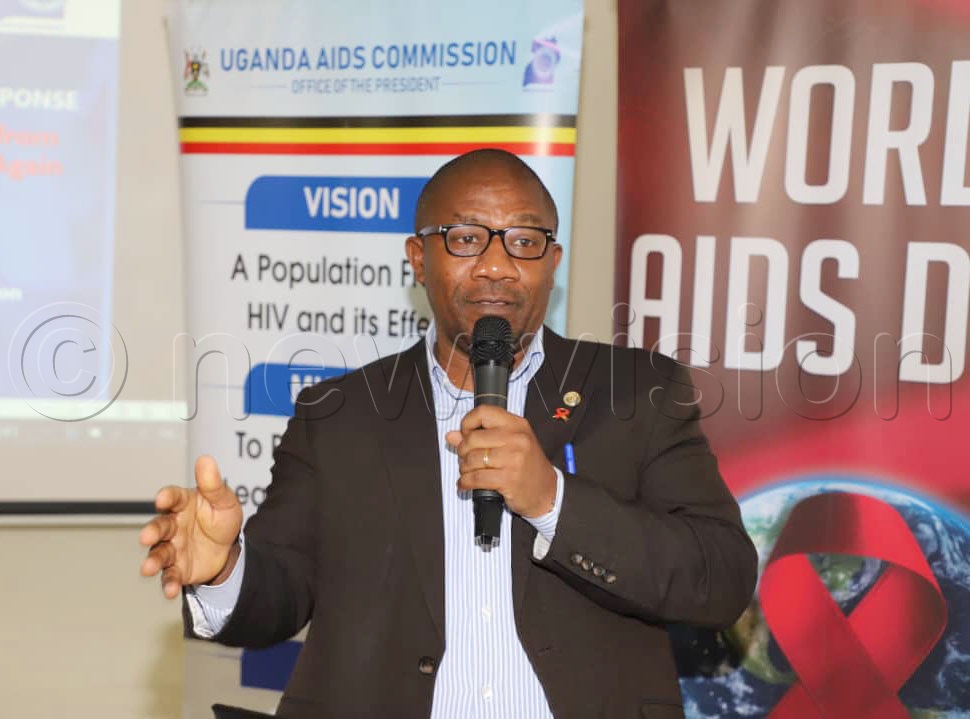National HIV prevalence, new infections drop — new report
Although we are seeing a generalised epidemic, it has got pockets of concentration of HIV prevalence in cities, municipalities and also in locations around water bodies along the transport corridors, for example, the traditional highways.
Dr Vincent Bagambe, the director Planning and Strategic Information Uganda AIDS Commission, addressing Journalists at UNAIDS UNICEF head offices flanked by officials from UNAIDS MOH PEFPAR 01. (Photo by Agnes Kyotalengerire)
By Agnes Kyotalengerire
Journalists @New Vision
_________________
The national HIV prevalence has dropped to 4.9 % down from 5.1%, according to the 2025 national HIV estimates.
The same report reveals that prevalence is higher in women at 6.4 % compared to men at 3.4%.
Although we are seeing a generalised epidemic, it has got pockets of concentration of HIV prevalence in cities, municipalities and also in locations around water bodies along the transport corridors, for example, the traditional highways.
The director of Planning and Strategic Information, Uganda AIDS Commission, Dr Vincent Bagambe, said there is a need to scale-up HIV prevention efforts, especially reaching those pockets of concentration to ensure prevention interventions reach there, but also those who are HIV infected get the treatment.
Dr Vincent Bagambe, the director Planning and Strategic Information Uganda AIDS Commission addressing journalists. (Photo by Agnes Kyotalengerire)
Regarding new HIV infections among all ages, Uganda has registered a 61% reduction, which translates into 37000 new HIV infections per year, compared to 15 years ago, when over 97000 new HIV infections were registered.
The epidemic still carries a female face because of the 37,000 new HIV infections, about 14000 were young people aged 15 to 24, with the majority, about 70% being adolescent girls and young women. About 17% of the new HIV infections occurred among young boys and men who are not circumcised but still engage in unsafe sexual practices.
In addition, there has been a 75 percentage reduction in mother-to-child transmission, which implies that Uganda has not yet attained the elimination stage.
In this regard, a total of 4700 children acquire HIV from their infected mothers. However, Dr. Bagambe described the indicators as a success compared to 15 years ago, where close to 18,600 new HIV infections from mother to child. So, reducing it to less than 5000 infections is an achievement, although a lot more is needed, Dr Vincent noted.
In terms of AIDS related deaths, in 2024, a total of 20,000 Ugandans succumbed to AIDS related conditions.
“This is unfortunate because the technology for keeping them alive is available with antiretroviral drugs (ARVs) offered in most health facilities across the country. Not to mention laboratory facilities to monitor those who are doing well and not, as well as detect the opportunistic infections that cause death,” he said.
Uganda is progressing steadily toward the 95-95-95 targets, particularly among adults. However, service gaps remain for men and children, particularly in achieving viral suppression, Dr. Bagambe noted
The 95-95-95 targets were adopted by Uganda in the presidential fast-track initiative of ending AIDS as a public health threat.
The targets stipulate that by 2025, 95% of the people who live with HIV in Uganda will have tested and know their HIV status. Of those who will have tested, about 95 % will have been put on treatment, while 95% of people on treatment will have suppressed the virus in their bloodstream.
As of December 2024, the number of people living with HIV in Uganda was 1.5 million. Of those 94% had tested and knew their positive HIV status. This implies that there is some elusive 6% of the people living with HIV in Uganda who have not tested and perhaps do not know that they are living with HIV.
Additionally, of those who have tested, about 90% have been put on treatment, and 97% have attained their viral load.
The worrying bit is that children have been left behind, with only 80% children (0-14years) having been tested for HIV. This means that 20% of children are out there, not tested and therefore have no opportunity to access care and treatment.
The indicators were unveiled during a media conference on the Global HIV Updates and Uganda's HIV Estimates 2025 at the UNAIDS and UNICEF headquarters in Mbuya, a Kampala suburb, on Thursday, July 2025.
Also in attendance were officials from the Ministry of Health, Uganda Aids Commission and UNICEF/WFP/UNAIDS.
